The Builders Podcast featured a engaging discussion on empowering Web3 developers, hosted by Ali from the Flow Foundation alongside Cam and Harry from HackQuest. The conversation centered on HackQuest’s mission to bridge the Web2-Web3 developer gap, Flow’s innovations in creating user-friendly blockchain solutions, and key trends shaping the Web3 ecosystem.
HackQuest’s efforts focus on hosting hackathons, educational events, and fostering innovation-driven communities. Their mission is to empower builders and technical founders, ensuring a steady pipeline of talent into Web3. Drawing from years of experience, they shared lessons on building successful communities, emphasizing mutual support, consistent engagement, and recognition. By prioritizing technical discussions and long-term goals, HackQuest creates collaborative spaces while avoiding distractions like token chatter.
The discussion highlighted the importance of two developer personas in Web3: builders, who contribute technically, and founders, who drive vision and execution. Both play essential roles in sustaining a healthy ecosystem, requiring tailored support to foster innovation and growth.
Flow’s approach to blockchain usability was a focal point, with its innovative solutions such as gasless transactions, wallet-less applications, and sponsored fees, all designed to lower barriers for mainstream adoption. These features, combined with the Crescendo upgrade—Flow’s largest to date—introduce EVM equivalence and advanced developer tools, making it easier for Solidity developers to build scalable, consumer-friendly applications within the Flow ecosystem.
A recurring theme was the importance of building in public. Publicly sharing progress fosters collaboration, visibility, and motivation, with emotional recognition and professional support playing critical roles in strengthening builder engagement and long-term contributions. Builders thrive on both monetary and emotional support, and ecosystems must consistently spotlight projects, provide growth tools, and nurture resilience through regular feedback.
The conversation underscored a shift in focus toward consumer-facing applications like gaming and social platforms. With robust infrastructure now in place, solving real-world problems and onboarding mainstream users have become priorities for achieving mass adoption. By aligning initiatives from grassroots programs like HackQuest with cutting-edge blockchain infrastructure like Flow, Web3 is poised to usher in its next wave of innovation, empowering builders and fostering vibrant, impactful communities.
Matt: Welcome everybody, and thank you for tuning in to The Builders Podcast, Singapore Rooftop Terrace Edition.
We're really excited to be chatting today. We have Ali from the Flow Foundation, and we have the HackQuest team here. We’re super excited to get into what’s going on with builders today—what are some of the pain points of the builders, how we’re improving on those, how HackQuest is being a part of that, and how Flow is being a part of that. I think we’re going to have a really fun conversation, so thank you all for being here. Let me just kick it off to the HackQuest team. Maybe Cam, you can go first and introduce yourself, and we’ll go across the line.
Cam: Yep, hi everyone. Thanks for having me. My name is Cam. I’m a co-founder of HackQuest, and I mainly lead product and operations.
Harry: Hi all, my name is Harry, one of the co-founders of HackQuest. I primarily focus on BD, growth, marketing, all that fun stuff—the whole shebang.
Ali: My name is Ali. I’m an outbound product manager at the Flow Foundation, and some of the things I work on are developer education, developer tooling, and the whole strategy for developer engagement and growth.
Matt: Awesome. Well, I’m Matt, and I’m on the community team here at the Flow Foundation. You know, I just vibe around the internet—it’s a great time. But this is awesome! We’ve spoken a little bit before this podcast, and it seems like what you guys are doing is really exciting. I want to let our audience get to know a little bit more about what you’re doing and some of the builders we’re going to be encountering on our world tour.
We’ve started this world tour, and this is stop number one here in Singapore—it’s a great first stop, I might add. Absolutely. In just a couple of days, we’ll be activating at the ETHGlobal hackathon, hacking on DeFi and consumer DeFi. I’m really excited to get into that. But so people know, we’ll give a little bit of backstory on Flow in a moment.
Matt: First, Harry, do you want to tell us a little bit about what HackQuest is?
Harry: HackQuest started as a founders’ community back in 2021. We hosted a lot of Web3 hackathons because, after exiting our previous startup, our team—which has been together since 2016—was looking for the next big problem to solve. We started as a founders’ community for emerging technology, hosting hackathons, huddles, and meetups to get to know each other. Good vibes all around.
One thing we noticed around 2021–2022 was that 60% of our builders in the community were interested in Web3. We’re no strangers to Web3 because, actually, one of my first essays was on blockchain back in 2014. Our CTO is a PhD in cryptography, and Cam has been trading crypto forever. So, we’ve all been borderline crypto for years.
We’ve always been interested in the technology side of blockchain and how it affects our everyday lives. Of course, our focus has always been on education. All four of us come from relatively technical backgrounds. I’m the least technical on the team—I come from a data science and statistics background, more on the teaching side. The other three are hardcore programming and computer science people.
Harry (continued): We noticed that a lot of the founders and developers we were working with in Web3 weren’t many in number. At events, it was the same people, the same group, having fun. In 2022, we came across a report by Electric Capital, written by Maria, who we invited to our events. We had a chance to talk several times. One data point really caught our attention: the discrepancy between Web2 and Web3 developers.
Right now, we have about 28.7 million Web2 developers globally. If we look at the open-source developer count in Web3—which is largely open-source, just to highlight—we have roughly 26,000 monthly active developers and 7,661 full-time developers. Wow. And even if we estimate the closed-source numbers, adding a multiplier of five or ten, it’s still significantly smaller. We’re still thousands behind.
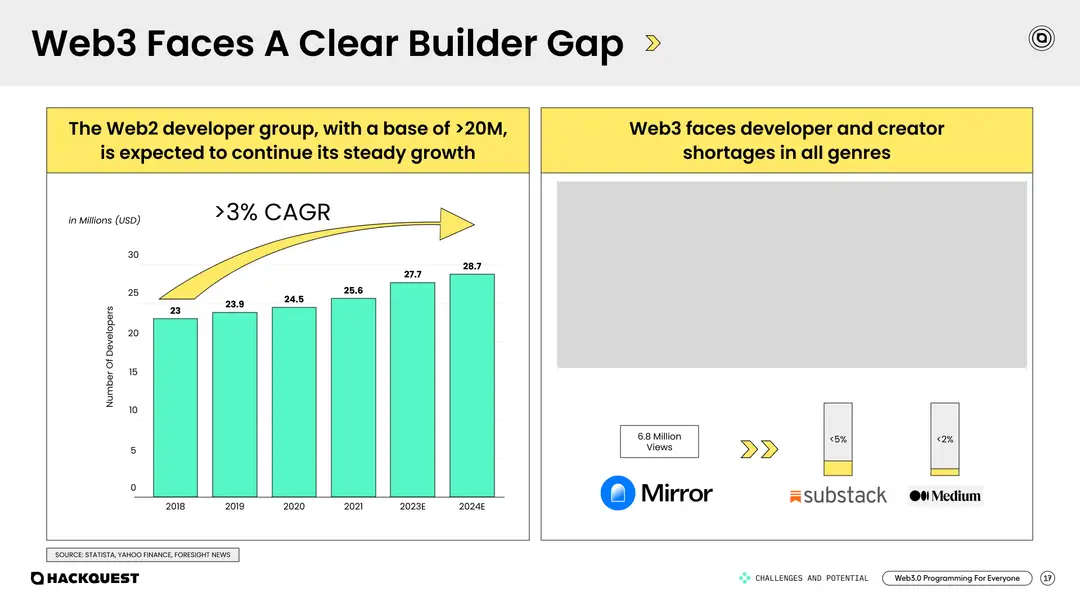
Source: HackQuest Developer Education Report, 2024
We saw this gap and recognized the opportunity. Given how much we’ve invested in a decentralized future, we knew the space needed more builders, more developers, more technical founders, and folks who understand the theoretical reasons for building in this space. That’s why we’re doing this—to onboard more developers into Web3.
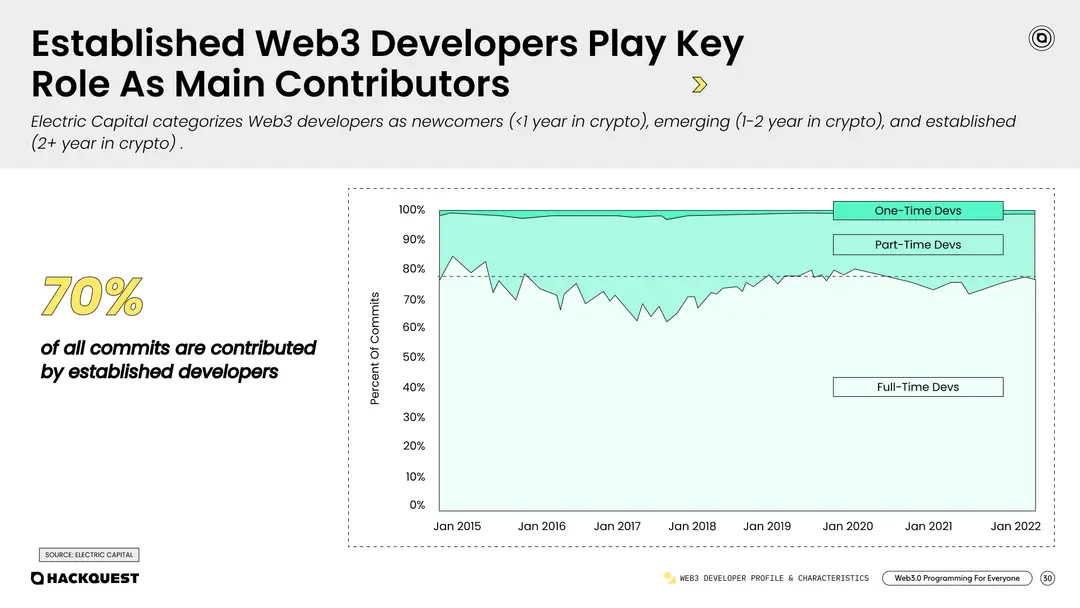
Source: HackQuest Developer Education Report, 2024
HackQuest is, directly speaking, a Web3 developer education platform. We help leading blockchains get more developers and founders to build on them. We do this through education, events, hackathons, hacker houses, and accelerators—the whole pipeline of growth and onboarding.
Matt: What you mentioned about starting as a founders' community is fascinating. You said HackQuest was originally about building communities in emerging technologies. What was the initial desire to start fostering these communities in that sphere?
Harry: Yeah, it’s so exciting to meet folks who are young, energetic, and passionate about innovative things that can change our everyday lives—like AI, Web3, blockchain, and the Internet of Things. Naturally, when smart, ambitious people gather, great things happen. At the time, HackQuest grew from that vibe.
We saw people building human-interfacing computers, and experimenting with rocket materials—things I don’t even fully understand, like bio-attack materials. There were engineers and scientists gathering in basements or fancier spots, building crazy stuff together day and night. That kind of innovation and energy is infectious. It’s why we’re so glad HackQuest was born from this movement.
Matt: That’s awesome. What are some of your biggest learnings about starting a community? One unique thing about Web3 is how almost every product has an inbuilt mechanism for creating a community around it. Whether it’s a meme coin, a DeFi protocol, or an L1 blockchain, almost every project launches with its own Discord server. You don’t see that kind of direct engagement or fostering of communities in Web2. From your experience, what are the ingredients for building successful communities in this space? Any advice?
Harry: Absolutely, I can kick that off. Cam has been building a ton of communities in Asia, so he might have more to add. But I’d say the first thing is the setup. I saw this chart once that explained the difference between a community and just a group of people. A group of people is often a one-way communication setup, whereas a community is about mutual support. It’s two-way communication, like the difference between Web1 and Web2.
A group passively receives information, while a community organizes things organically. Members start conversations without needing constant leadership or intervention. That’s the end stage of a good community—when it functions on its own. To get there, you need mechanisms that encourage such behavior.
One key ingredient is creating paths for recognition. It doesn’t have to be monetary. It could be a badge, a shoutout, a podcast interview, or even a blog article. Recognizing people builds that sense of community. Another key ingredient is the vibe, the energy that members bring. I talk to developers and founders across protocols, and the number one thing they mention about marketing or dev relations is word of mouth. The key figures in these communities—like Patrick Collins or Nader Dabit—are passionate about learning and sharing. They don’t just show up for money or career reasons; they come to explore what they can build and to connect with others who feel the same way.

Source: HackQuest
Harry (continued): The third ingredient is consistency. Be consistent in posting, hosting events, and staying present. It doesn’t have to be elaborate. Even saying “GM” on Telegram every day matters. When members start doing that organically, you know a real community has formed.
Cam: I totally agree. To add a personal story—our community is unique because many members recently transitioned from Web2 to Web3. For them, Web3 was initially unfamiliar and strange. But we set up a culture of accessibility. Any builder in our community can book time with Harry, me, or anyone else to discuss their projects and how we can help.
At first, people were cautious. They’d ask, “Why would you help me? What do you want from me?” But after months and years of doing this, the community began to trust us. Members started helping each other and forming connections. That’s when the vibe of the community really grew. Now, it sustains itself, and we just need to nurture it and keep the good vibes going.
Cam: Another thing I think is that, especially for a DAO community, it’s very important to keep a long-term perspective and to make the community very pure. We know that a lot of communities, especially those that talk about tokens, prices, and such, can lose focus. In our community, our members mostly talk about the things they’re going to build. They share technical conversations and ideas. We really want to keep the community free from unnecessary noise and distractions. That’s another key point I wanted to add.
Matt: I absolutely love that definition of sharing resources, and I love the point on consistency. Even outside of Web3, some of the most genuine aspects of community I’ve experienced come from people sharing resources. For example, sharing food. When you’re going through a tough time, someone might show up with medicine or groceries. Last month, I was super sick, and a friend came to my apartment unprompted with a bag of groceries and fruit. That’s a real friend. They were sharing resources, and I felt a genuine sense of friendship and bonding. I thought, “You know what? This is a true friend.”
Of course, they got sick from visiting me, so a week later, I returned the favor. But that sense of sharing and caring is what real community is about.
It’s interesting because, in a lot of ways, Web3 is uniquely situated for that kind of sharing, especially when it comes to developers. All the code you deploy on-chain is inherently open source—it’s inherently shareable. Building on your earlier point, when you go into these Discord channels, a lot of people think, “Oh, I’ll just create a Discord server, a GM channel, some rules, and add a bot. Then that’s a community.” But that’s not it.
From what you’re saying, it’s a two-way, bidirectional relationship. When you’re creating these channels and communities, you need to think about how to create opportunities for people to get involved. For example, if you’re making a video game, is there a way people could contribute ideas? Could you get product feedback? Could they get involved in voice acting for characters? How can you structure the community from the beginning to create as many opportunities as possible for people to get involved and invested in its future? I think that’s absolutely amazing.
Matt: I think that’s tied into another point, and I want to segue a little bit. If we define healthy communities as those that foster sharing of resources, it seems like unhealthy communities are those that are one-sided, don’t share, and are more toxic. What do unhealthy hackers and developers look like? What do very healthy builders look like—those who end up becoming founders or contributing and growing? Are there synergies there? What have you seen working with all these developers yourselves?
Harry: That’s a really good question. To be frank, I don’t know if “healthy” and “unhealthy” are the best words for it, but I totally get your point. We almost label them as two personas when we talk to a lot of very developer-focused protocols. Some recognize it immediately, and that’s how we know they’ve felt it too. They’ve been investing in developers, so they know there are two distinct personas.
HackQuest started in the Greater China area, but we’ve been tapping into India, Brazil, Nigeria, different parts of Southeast Asia, the U.S., and elsewhere.
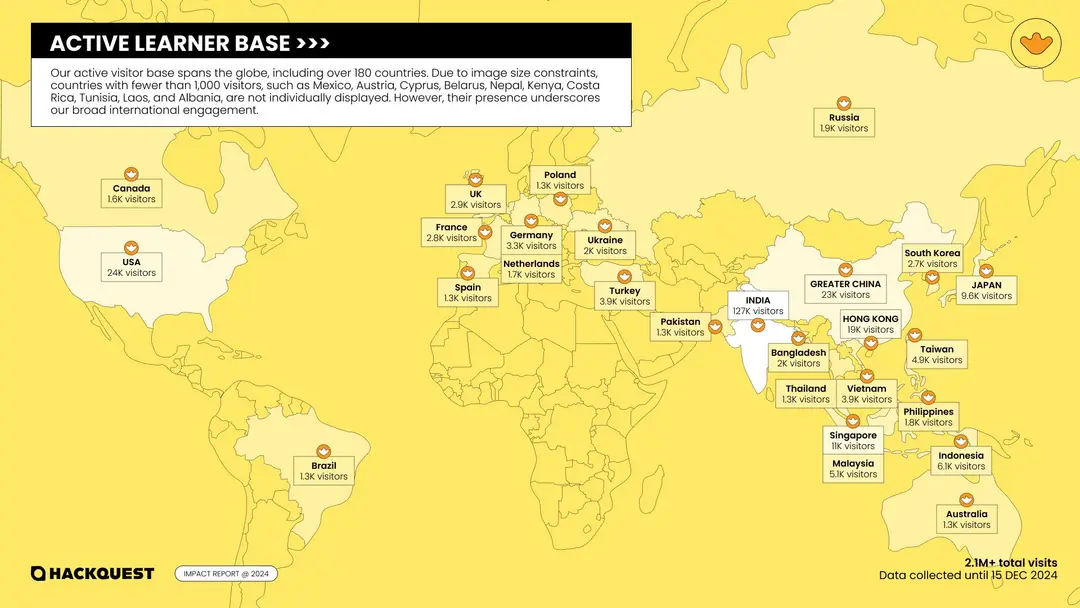
Source: HackQuest Impact Report, 2024
What we’ve seen globally is that a lot of developer ecosystems want two things: first, they want the numbers to go up, and second, they want quality projects. That’s been a trend, which makes sense. You need enough builders in the space, but you also need a lot of good projects.
But to be honest, these are two different personas. Some ecosystems think, “If we get more developers, we’ll get more quality projects,” and that is true to some extent. It’s a funnel in some ways. The more developers you have, the more quality projects you might have, and the more quality developers you’ll attract. Some will convert into founders, and those founders will become better founders, raise money, and create pillar projects. That does make sense to some extent.
However, something we’ve noticed is this distinction between two developer personas. One type is the developer who may never want to be a founder—and that’s okay. Many of them are incredible hackathon winners. We’ve personally hosted hacker houses where, out of a couple of thousand people, you have 10 serial founders. These are people who have won five or 10 hackathons and have been building in the space for years. They’re working at amazing protocols as engineers, and their hackathon projects are incredible.
Sometimes, I get jealous. I see these projects and think, “Wow, these people are so amazing. They have brilliant ideas all the time.” They’ll build five hackathon projects during a single hackathon. If it were me, I could think of ways to commercialize each one of them. If they wanted support, I’d be happy to help. But some of them don’t want to take it to the next level—they just want to be contributors to other protocols.
Harry: That’s okay. But that’s one builder type—there are actually a lot of folks like that who are more the builder or developer type. Then you have the founder type. Don’t get me wrong, I can definitely see a lot of developers or builders transitioning into founders—most of us came that way. But again, some folks just naturally lean one way. Maybe they come from a Web2 founder background, so they’re more inclined to start a Web3 company as a founder rather than joining one first and then starting their own.
For many native folks, though, they’ve never been founders before. They start as builders and stay as builders. They might be missing that tick, that tool, or that push to become a founder. That’s something we’re very, very interested in. I know Flow has been very invested in that process too. I’d love to chat more about that, but let me elaborate and finish this part of my thinking.
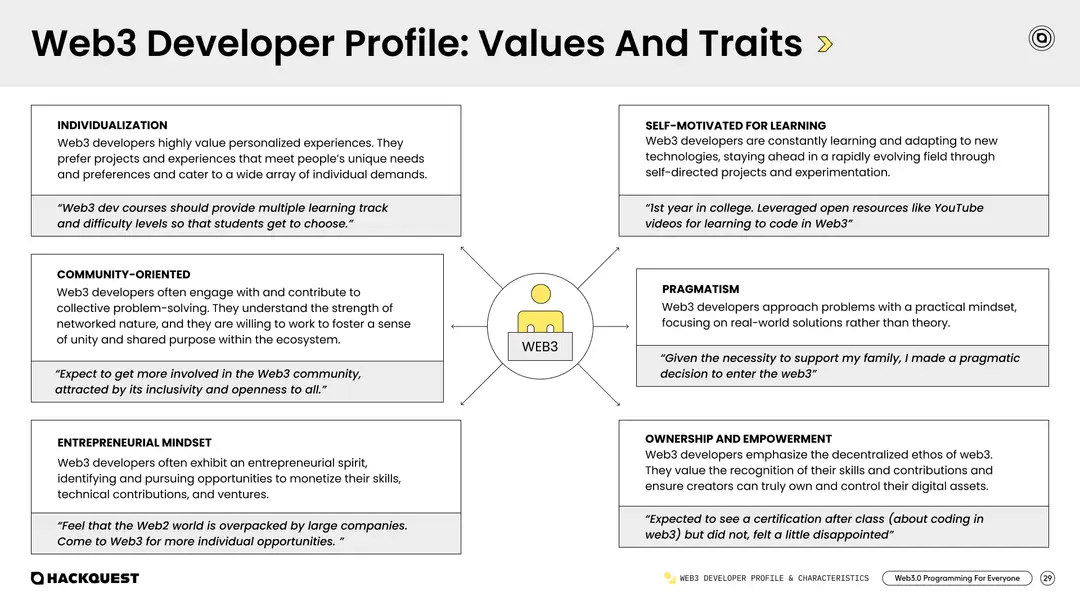
Source: HackQuest Impact Report, 2024
The second persona is the founder. Again, some come from Web2, while others just naturally have that urge. They have a vision or a problem they want to solve. Those are the people we try to capture as early as possible to give them the support they need—whether it’s funding, idea generation, or, as Cam mentioned, jumping on a 15- or 30-minute call to brainstorm ways we can help. We share resources, invite them to communities of different sizes, and just aim to be helpful in general.
So, if we’re boiling it down to which persona is better for the ecosystem, I think it’s a chicken-and-egg problem. You need both. You need the founders to drive actual, meaningful use cases to onboard users—which we’re still lacking—and you need the developers to sustain those protocols. There’s a famous saying in Silicon Valley: some founders are the "starters" while others are the "maintainers." You need both archetypes for a healthy ecosystem to be formed.
Harry: To be honest, I think we’re missing both right now in the space, and that’s exactly the reason why we exist today.
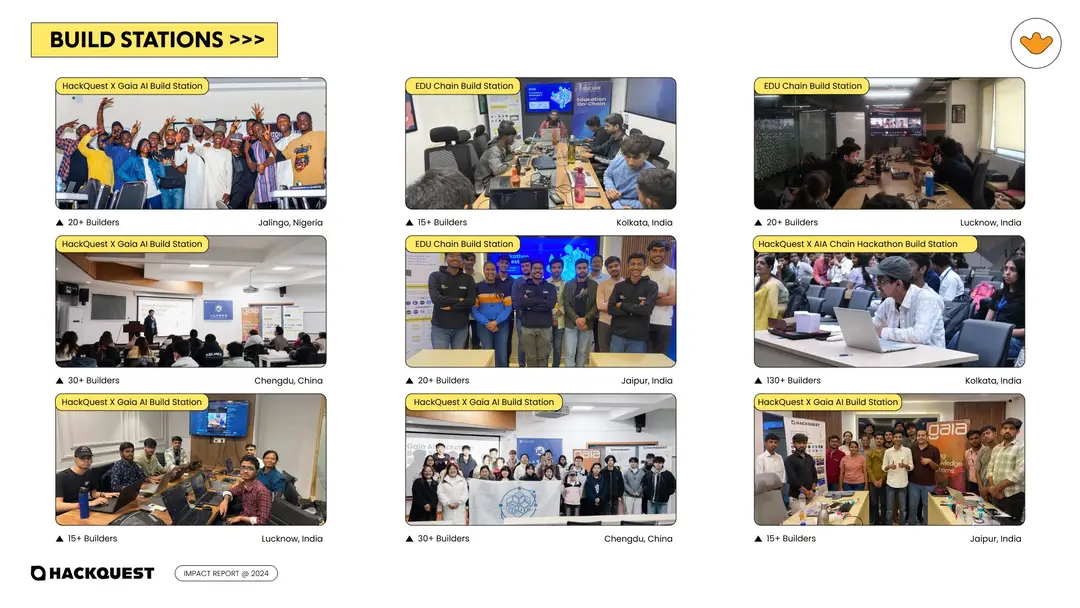
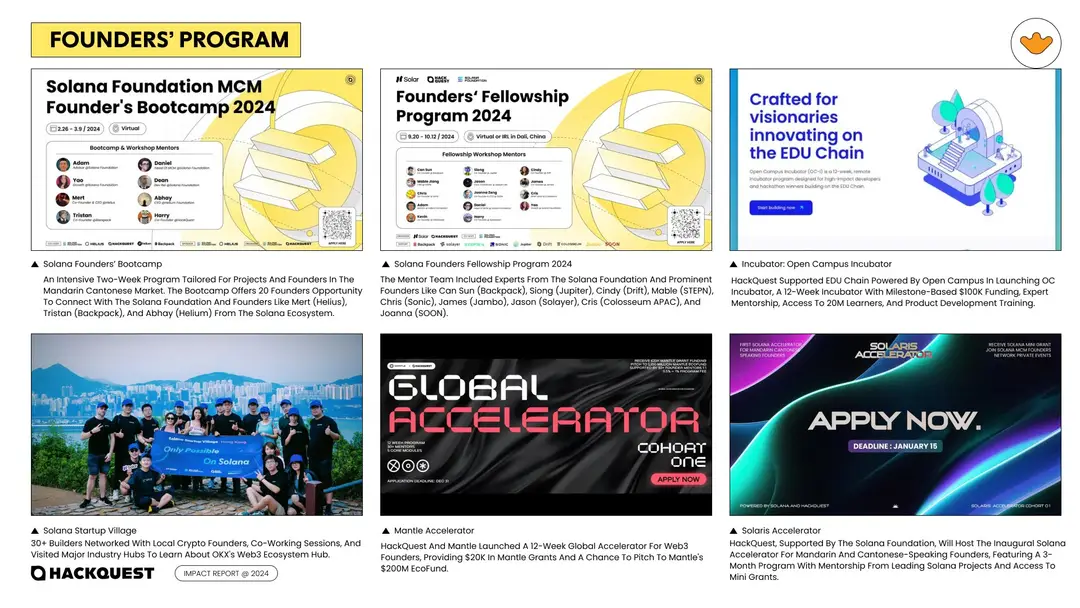
Source: HackQuest Impact Report, 2024
Matt: Well, and maybe there’s a piece to this about the power of community. A lot of times, you’re scrolling through Twitter, seeing people launching projects and products, and it seems like they came out of nowhere. Suddenly, they have $50 million TVL, and it’s like, "Oh my gosh, they’re so successful—it’s incredible." But for someone starting out, it’s hard to even know what the first step is to get to that point, if that makes sense.
But being in a community, you can see people progress. You might think, "Oh, that person who I joined this community with—they were just a hacker like me at a hackathon. Now they have their own project, their own product, and it’s successful. I watched them do it." That makes you think, "Maybe I can do that too." Right? That’s where recognizing and empowering your builders becomes so important.
Matt: That’s something we’re very focused on here at Flow, especially with our new rewards program coming up. I’ve been thinking a lot about how we can align incentives between protocols, builders, and users. And not just align those incentives, but empower builders—make them feel recognized, part of a community, and give them a platform to elevate themselves, be recognized, and be rewarded for doing so. Ali, do you have any thoughts about how our rewards program fits into that and helps foster the kind of community we’re talking about?
Ali: Exactly. A little bit of context—the Flow blockchain has played a very pivotal role in the evolution of the Web3 industry as a whole. Our chief architect and co-founder of Flow is actually the one who coined the term "NFT." This originally came out of Dapper Labs, which is the team behind CryptoKitties.
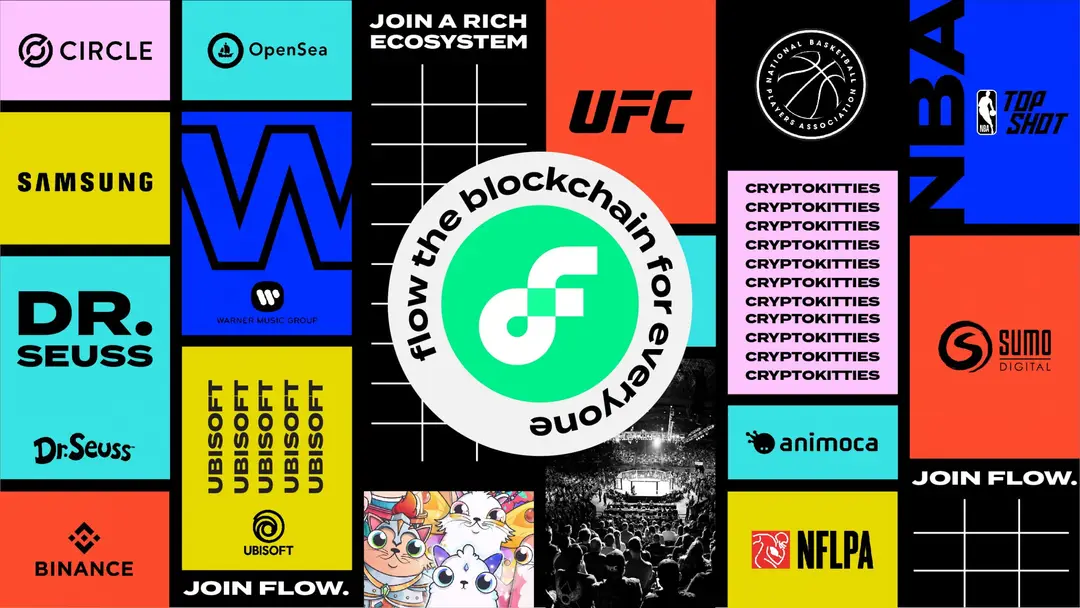
Source: Flowverse
CryptoKitties, as you know, is a household staple in Web3. Everyone’s heard of it. They launched cats on-chain, and all of a sudden, people were like, "Oh my God, these are so cool, they’re fun, I can breed them, I can get more." It became this fun activity, and suddenly, people were breeding cats on-chain like crazy.
Of course, no one initially expected this to be a use case. This was before DeFi and everything else we see today. But through that experience, we realized there was a massive scalability problem on Ethereum.
The inception of the Flow blockchain really came from asking, "How can we create tooling and an environment for builders to overcome all the barriers they face when trying to build Web3 applications?" From a scalability perspective, we thought about creating a multi-architecture that allows scalability without sharding.
We also considered how to improve user experience. For example, think about your mother, uncle, or aunt. If you send them a link to an application—whether it’s DeFi or a game—the first thing they see is "Connect Wallet" in the top right corner. They’re like, "What the heck is that?" They click it, and now they have to memorize a seed phrase. It says, "Don’t save it to notes," but they were just about to save it there. Now they’re told to write it down, but also to keep it somewhere safe because if it’s on paper, it could burn. They’re already stressed, thinking, "Okay, shoot."
Then, after they’ve done all that, they try to log in and can’t do anything because they don’t have any gas. Now they’re asking, "What’s gas? Is that like taxes?" Then they have to figure out where to get gas. Their friend tells them to go to an exchange, but when they try, their bank blacklists it. They end up on a call with the fraud department for hours. By the time they’ve sorted it out, it’s been a whole day, and they haven’t even started playing the game!
There are just so many barriers, and it undermines a lot of the value propositions of Web3—like true ownership, privacy, and the ethos around decentralization. The challenge was to maintain those core principles while also improving the user experience for developers and end-users alike.
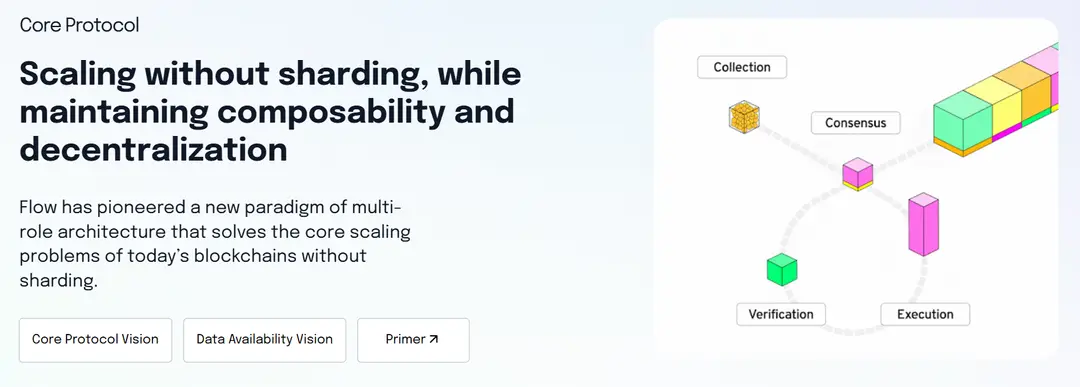
Source: Flow Core Protocol
That’s the mindset we’ve had with Flow—creating protocol-level primitives like account abstraction at the protocol level. This allows for wallet-less applications to be created more easily. Users can just put in their email and start using the app. As they go further down the rabbit hole, they can gain full ownership of any assets they’ve acquired while playing around with these applications. Eventually, they can connect those assets to their own non-custodial wallet.
Similarly, with gasless experiences, we created a transaction model that separates the payer, the authorizer, and the proposer. This opens up a lot of potential for applications to sponsor transactions, meaning end-users experience no transaction fees and no complicated account setup, while still getting all the benefits of Web3.
At a high level, over the last several years, we’ve worked with some of the leading IPs and brands in the world—Disney, NBA Top Shot, and others. These collaborations were kind of like experiments to test out our vision for a fully scalable, top-tier user experience ecosystem.
Take NBA Top Shot as an example. Millions of people around the world, who weren’t already in the Web3 ecosystem, started buying these moments and utilizing digital collectibles built on top of the blockchain. More importantly, it proved that if you remove those user experience barriers, you can bring millions of mainstream users into applications that benefit everyone.
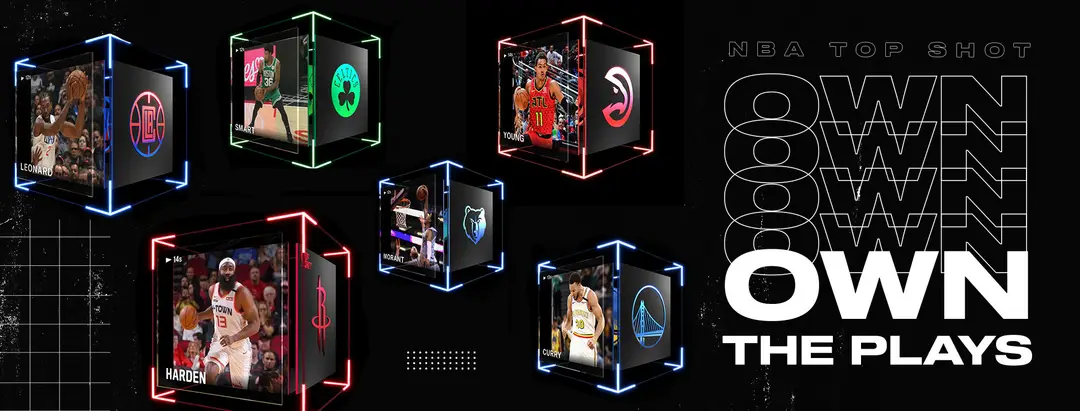
Source: Flow Blockchain
Ali: What we've done up until now is work with leading brands like NBA Top Shot. On some days, NBA Top Shot had more transactions than all of Ethereum. We’ve proven that you can create scalable applications and remove a lot of barriers.
Earlier this month, we launched Crescendo. Crescendo is the largest upgrade ever to happen on our blockchain.
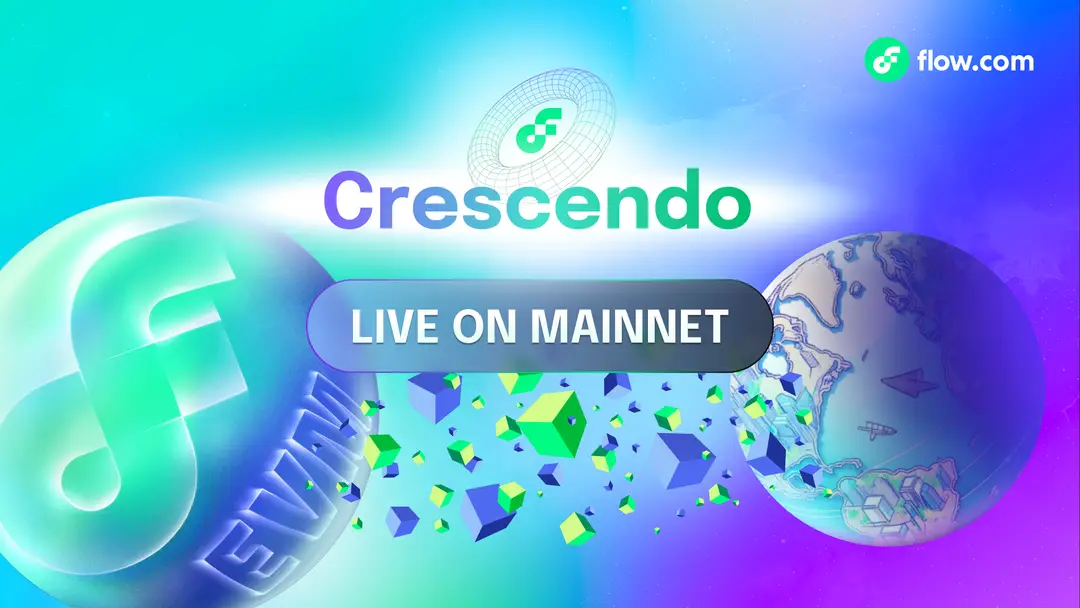
Source: Crescendo
One of its key features is adding more user experience improvements to the native programming language environment. For example, we introduced features like attachments, which you can think of as molding for smart contracts.
On the other side, we’ve essentially implemented EVM equivalence. This means any EVM developer can take their Solidity code, use their favorite tools, and instantly deploy on Flow without any configuration—in seconds. That tears down barriers for the 90%+ of developers in the ecosystem who are familiar with the EVM toolset.
In the last several weeks, we’ve seen exciting growth. Several thousand contracts have been deployed on our testnet for EVM. We’ve been receiving tons of messages from developers eager to launch.
Tying this all together with our rewards platform, we now have an ecosystem where mainstream users can engage with scalable applications, and everyday Solidity developers can access Flow's IPs, assets, and communities. On the Cadence side, they can also access all the TVL coming in from the Solidity and EVM side.
The rewards platform itself has two main components. On the user side, users can lock Flow into the ecosystem and earn points. Already, in just weeks, we’ve seen almost $25 million worth of Flow locked into the ecosystem. This massive TVL is creating opportunities for users to allocate their locked Flow or directly engage with exciting new projects launching in the ecosystem. They can receive rewards or incentives simply by using mainstream consumer applications being launched now and in the near future.
On the other side, the rewards platform provides a robust acquisition, activation, retention, and referral mechanism to empower builders and communities.
Ali: How can we seamlessly support developers at every stage, meeting them where they are? Whether they’re hackers in a university, developers looking to make open-source contributions and test new technologies, or someone thinking about starting their next startup—whether you're in university working on a side project—our goal is to create a system where the more active you are in shipping and the more impactful your projects are on-chain (i.e., the more product-market fit they have and the more real-world problems they solve), the more rewards, perks, and opportunities you unlock.
I can’t share too much detail yet, but suffice it to say, the rewards are awesome. You’ll hear a lot more about this in the coming weeks. At a high level, if you’re a developer joining us on this world tour, whether in-person across four cities or through our online version, know that what you’re building isn’t just a weekend project. Your work at this hackathon can be part of a much larger system. Whether you continue working on what you started or pivot to something new, you’ll receive multi-tiered support to create something meaningful—something that can truly impact everyday people, not just a small niche of crypto enthusiasts.
Matt: That’s so exciting! Disclaimer: I don’t know all the product details, but I think this is crucial. Over the years of building in this space, one of the hardest challenges has always been reputation. Vitalik wrote about this years ago, and it remains a tough problem to solve. Specifically, the developer reputation layer—how we track, recognize, and connect everything developers are doing and shipping—is critical. Developers deserve far more recognition for their contributions.
We were just chatting earlier about how challenging this cycle has been for builders, especially the technical devs who are constantly shipping. It’s tough to be a builder when there’s so much distraction, and their efforts don’t always receive the resources, support, or recognition they deserve. That’s why I think creating something to track and reward their contributions at scale would align perfectly with the ethos of Web3—providing fair distribution of resources and recognition. Count me in for that kind of initiative.
Cam: Broadly speaking, we’ve all grown up with platforms like the iOS and Android App Stores. But for builders, getting into these stores has always been an obscure, cumbersome process. Once you’re lucky enough to be admitted, you face a 30% transaction tax. Web3 has inherently promised to reward participation, and I see this decentralized rewards program as a fulfillment of that promise.
If you’re a builder, you should be rewarded. If you’re a user, you should be rewarded. These incentives should be intertwined. Community is already integral to every product—heck, even a meme coin might have a chat built into it! This new distribution strategy and platform could create incredible opportunities, and it’ll be exciting to see what emerges as a result.
We’ve seen a few attempts to align incentives between builders and users, but I think we’re making significant improvements. This is going to be amazing. Absolutely.
Cam: I think this perfectly coincides with what we’re trying to do with builders because, as we all mentioned, it’s very difficult sometimes to transition from being a builder to becoming a founder. I think this really helps because one of the great things about Web3 is that, as a builder, you can get positive feedback every step of the way.
For example, right now, the main way to do this is through hackathons. You participate in a hackathon, you get rewards, and when you’ve accumulated enough rewards, you might start to think, “This is a good project. I should invest more time in it, maybe even become a founder and do it full-time.”
I think with this reward system, if we could track progress not just through milestones, like hackathon points or completion milestones, but also by tracking what builders are creating every day and the traction their apps gain as they grow, it would establish a strong positive feedback loop for builders. This could be super helpful for encouraging builders to take that next step.
Matt: Yeah, well, I think you’ve touched on something important. There’s a statistic floating around about how a certain percentage of builders will eventually become founders. It’s almost like taking shots at product-market fit—how many shots do you need before you hit it? Hackathons are a great way to do that, but I think there’s been a bit of a disconnect. From what I’ve seen, people often have 5 to 10 great ideas during a hackathon, and any of them could become a viable business.
But they don’t always cross that Rubicon. Distribution could be an answer to that disconnect, something more persistent than just a one-off event. Some people have experimented with persistent hackathons or long-lasting online hackathons. But even those tend to follow the same model: submit your project, get a grant or reward, and then move on.
What we’re talking about here is different. Builders can start building during a hackathon, as they already would, but on the tail end of that, there’s an opportunity to grow the project further and see where it goes. It’s an exciting opportunity for builders who should definitely be paying attention.
Ali: I think your point about consistency ties into the industry’s need for regenerative and sustainable systems of support for builders. At the end of the day, one of the unfortunate realities plaguing the industry is that incentives are often geared towards short-term gains. Many people don’t see grants as startup funding; they see them as an end goal.
For example, someone might think, “I’ll get this grant, launch a project on this chain, and then when the grant runs out, I’ll jump to another chain and get another grant.” This creates a kind of mercenary culture. Incentives that aren’t well thought out lead to chain-hopping and short-term projects that don’t have product-market fit. Builders end up without a sustainable business model or solutions to real problems—they’re just building because, right now, being a builder is a hot commodity.
You see this dynamic at events like ETHDenver or other conferences. Sometimes, it feels like there are more app chains than builders—more chains than builders. Even at hackathons, you’ll notice career hackers reusing the same projects from one hackathon to another. These individuals don’t want to actually build something meaningful or contribute to the ecosystem. They’re not interested in open-sourcing their work or solving real problems. They’re just creating projects to earn quick money, whether to buy a car or something else.
That’s not inherently bad, but as an ecosystem, we need more of the regenerative and sustainable side of things to be built into the system.
Matt: I think it’s important to be mindful when talking about “healthy” or “unhealthy” communities. I try not to pass judgment in that way. It’s just the reality of the ecosystem. If you want to sustain yourself, this is a viable avenue. To me, that says the incentives aren’t aligned or structured properly. If other parties feel disappointed or disheartened, it’s more a reflection of those misaligned incentives.
You mentioned CryptoKitties earlier, and I’ve been thinking about this energy recently. It’s that optimism and fire that come with being around an emerging technology. When I first got into crypto, it felt like the world was our oyster. We thought we were going to fix everything on-chain—it was going to be incredible. Over time, we lost some of that luster, but I feel like it’s starting to come back.
Part of that is due to improvements in user experience. There was a time when I didn’t feel comfortable telling friends or family about a product because the experience wasn’t great. I’d say, “You’re not going to have a great time, but here it is.” Now, when I see things like Disney Pinnacle, I feel proud to tell people to try it. I know they’ll have a great experience with a Web3 product, and that’s an amazing feeling.
That renewed optimism and excitement about the future will inspire people to take big swings again. It feels like this energy is converging into something fun and exciting.
Cam: Absolutely. Another key point here is distribution. For builders, getting positive feedback from real traffic and users is incredibly important. Grants and prizes are one thing, but seeing real people use your app is a crucial form of feedback. That’s why ecosystem resources are essential—not just grants or prize money, but also tools and support for builders to grow their projects.
Harry: Cam’s point gets to the heart of what incentivizes builders. Hackers often gravitate toward short-term gains because they’re tangible and immediate. You can almost feel the prize money as you’re hacking. Founders, on the other hand, don’t get that same immediate feedback. It takes years for a product to mature, for the UI/UX to be ready, and for users to start engaging with it.
We’ve been improving our product consistently, day and night.
A lot of our progress is due to our team’s dedication to design and continuous reflection. For instance, we conduct discovery calls with our community at least twice a week—some group calls, some one-on-one. We’ve done this since we started, and while it’s not a huge number, the consistency matters.
These conversations allow us to get feedback directly from users. Without a proper structure in place, it’s challenging for founders to create that positive feedback loop Cam mentioned. Hackers have a more straightforward path to validation because the industry gravitates toward short-term gains. That’s fine for those who are excited by short-term results, but founders who are in it for the long haul need better support.
Matt: Exactly. It’s not about blaming the players in the ecosystem but about creating a system and structure that encourages long-term building. We need to ensure founders aren’t discouraged from their missions while still allowing hackers to use hackathons to pay their bills. It’s about striking a balance so both groups can thrive.
Ali: Right, I think one of the beauties of Web3 is the comparatively low cost of capital compared to other industries. That has helped people from around the world change their lives. Winning one hackathon can mean three months’ salary for someone in certain parts of the world. So, I don’t judge those who use hackathons to make a career out of it or hop from one to another. But at the same time, when thinking about pushing the boundaries of innovation, I don’t want to discourage founders from continuing to build their products.
The challenge becomes designing an ecosystem or structure that provides adequate incentives for long-term builders while still supporting short-term incentives. I think we’re at a point where there’s plenty of focus on short-term incentives, so now it’s time to shift toward encouraging the long-term vision.
Matt: Totally. At Token 2049 in Singapore, I met someone who saw my Flow shirt and came up to chat. He said, “Oh, you’re with Flow? I go with the Flow!” It was such a great interaction. He told me about how he had participated in a Flow hackathon about a year ago and learned so much through it. Hackathons have always been a fantastic vehicle for short-term learning, especially in computer science programs and universities.
When I was studying computer science, I didn’t know how to deploy a React app or set up a domain name for a website. Those things weren’t taught in class; I learned them through hackathons or by tinkering on my own. This guy told me that winning a stream in one of our hackathons paid for several terms of his university tuition. Now he’s working on a huge infrastructure project in the space.
Even if someone is just participating in hackathons for the prize money, they’re still learning, gaining tangible skills, and contributing to the ecosystem. That creates a feedback loop that supports the overall Web3 space.
Harry: Absolutely. To shift gears a bit, you talk to so many hackers, builders, and founders. What do you think is missing in those conversations?
Cam: That’s a tough question. There’s always room to improve, and as developers ourselves, we tend to be critical of the ecosystem. But let’s narrow it down: What do builders say they want from protocols and networks?
Ali: Consistency is a big one. For example, we hosted a hackathon for EduChain, a Layer 3 built for education. It was incredible—4,672 hackers and 725 projects. On the final demo day, one hacker said something that resonated deeply with me. He was new to Web3, transitioning from Web2, and he was nervous and unsure about what to do. He didn’t know if he’d get validation or support, but someone pushed him to join the hackathon.
From day one, he started building and posting updates every single day on Twitter, documenting his journey. That type of builder, who consistently pushes forward and shares their progress, is exactly who we want to support. He ended up getting a small grant and is still building and trying to raise funds for his project, StreamBill.xyz.
Harry: That’s the kind of story that shows the importance of community. Some ecosystems excel at spotlighting hackers and providing not just monetary rewards but also emotional support. Sometimes, just getting a few likes or comments on a Twitter post can mean the world to these builders. Developers, especially those working solo, need that encouragement and sense of community.
Ecosystems have a responsibility to create that vibe and offer emotional value. Whether it’s a simple DM saying, “This is amazing, keep going,” or offering a Calendly invite for a quick chat, these small gestures can push builders forward. Not everyone has a group to lean on, so fostering that support system becomes crucial. It’s the ecosystem’s job to ensure builders feel that encouragement and connection.
Harry: I think this is a little abstract and not something everyone talks about, but it’s the first thing that came to my mind. Let’s be frank—ecosystems have come a long way, especially ecosystems like Flow, which have done an incredible job supporting builders over the years. We’ve seen other large ecosystems have GEM programs, incubators, hackathons—all amazing initiatives. But at the end of the day, I think ecosystems could do more to provide emotional value and support.
Having consistent high-touch points to track builders’ progress and offer support is crucial. That’s why I was so excited when I heard about the reward and incentive programs you’re building. It’s incredible because if you can track folks who are quietly building—even those who don’t participate in hackathons or other high-visibility activities—you can still ensure they get the emotional, monetary, or other support they need. These builders are likely to be more successful, and the entire ecosystem will benefit as a result.
Cam: Yeah, I totally agree. In addition to monetary support, emotional support from the ecosystem is equally important. One thing I’d add is distribution. Ecosystems could really help builders, especially those creating legitimate apps with good user experiences, by giving their projects wider distribution. Let people try these apps out. Flow, for instance, has a large number of users who could participate and engage with these apps, which would be incredibly helpful.
Matt: I love what you’re both saying. It ties back to the larger theme of community and resource sharing—the give-and-take aspect. One of the most underutilized tools in the space, surprisingly, is Twitter. I know that sounds odd because crypto Twitter is huge, but disproportionately, builders shy away from building in public and sharing what they’re working on. Instead, we tend to lurk—consuming what others post without actively engaging.
If you think of genuine community as sharing resources, many of us are just consuming rather than contributing. Building in public and sharing your work can unlock invaluable product insights, increase visibility, and foster better community engagement. It’s also a way to validate your ideas and avoid being tunnel-visioned. Instead of just pushing code to GitHub and wondering why no one is using your app, building in public lets you get feedback early and often, which can lead to better products and stronger communities.
Ali: That’s great advice. I know it’s intimidating to make your first tweet—it might feel unnatural or scary because what you put online stays forever. But if you think of it as contributing to a community, you’ll see massive benefits. I remember my first interaction with Flow being a like or seeing them on a Twitter space. It was such a cool experience to see a blockchain with an active Twitter presence.
Highlighting builders who choose to share their progress publicly, even small updates like a testnet deployment screenshot, is so exciting. It gives them recognition and a platform, which feels incredible as a creator. Emotional support like this has real, tangible value. Many times, when I talk to builders and ask what they want, of course, they mention the typical things—grants, resources, etc.—but they also express an intangible desire: they want to feel recognized for what they’re building. That recognition matters deeply.
Cam: I think that's so important, and I love that we get to do that. It’s awesome. Yeah, I totally echo that point because a lot of our builders, especially in places like China, don’t actually use Twitter as their social media platform. Most of the builders don’t even have a Twitter account. But in some of our profiles, we ask them to have one, and you can see a lot of new Twitter accounts that look almost like bots. They just name themselves HackQuest with their name and even use our logo as their profile picture.
Harry: It’s our first advocate! They use our HackQuest logo as their Twitter profile picture. You can always spot those “bots.” But they’re not bots; they’re real people. At first, they just retweet our tweets, like everything we post. But slowly, they start to show their own projects. They begin to follow other crypto people and famous projects. It’s really helpful to see them gradually get into the space and embrace the “build in public” culture.
Cam: Yeah, and they start to get this positive feedback loop. I remember one builder who got really excited when the head of dev rel for one ecosystem we work with liked his post. He screenshotted it and sent it in our group chat saying, “Wow, this is amazing! This person liked my post, and I have less than 10 followers right now!” That excitement was so real and motivating.
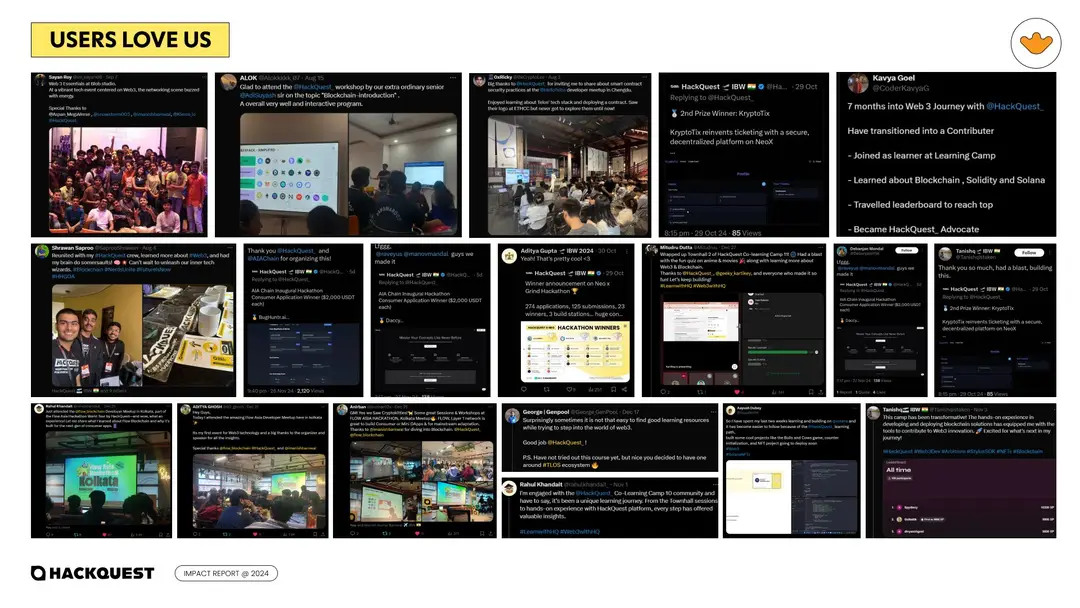
Source: HackQuest Impact Report, 2024
Matt: That reminds me of writing. A lot of people, when they first start writing, don’t have their own author’s voice. They copy others’ styles. Over time, they develop their own unique voice.
Harry: That’s such a good analogy. It’s interesting because, in some geographical areas, people feel a little shy about expressing themselves. China is a great example of this. Singapore and other countries in the region tend to have a more reserved culture compared to the West. But the “build in public” culture is something we’re trying to encourage. I once asked a shy builder why he started documenting his journey, and he said, “Oh, I just thought of it as writing a diary to myself. I don’t care how many people follow me.”
But trust me, when someone important in the ecosystem likes their post or comments, they get so excited. Cam’s example is spot on—they dedicate their projects to this blockchain forever because of that one interaction. It’s amazing how something so simple can make such a big difference.
Cam: In contrast, in regions like India, builders naturally document their journeys. There’s this ingrained culture of tracking progress and sharing, like “100 days of coding” or “14 days of learning Flow.” Gradually, they create a public record of their progress, and it becomes a positive signal for the ecosystem.
Harry: Some people in the community might see this as noise, but I don’t. As long as they’re learning, documenting their journey, and sharing publicly, it’s a positive signal. It’s part of building a robust ecosystem. The open-source nature of this space encourages learning and sharing, creating a feedback loop that leads to better builders and stronger communities.
Over time, these individuals might even become key opinion leaders (KOLs) in the space, like Nader, Austin, or Patrick, influencing thousands to follow their lead. If we can facilitate that feedback loop at the ecosystem level, which I think we’re starting to see, the future of the space looks promising. It’s what keeps us grinding every day.
Matt: Absolutely. I think it also comes down to meeting people where they’re at. For hackers who are less inclined to talk about what they’re building or who might be introverted, how do you find them, support them, and help them build something impactful? At the same time, we need to encourage others to share more and foster genuine community engagement. Balancing both sides is an exciting challenge.
Ali: I’m curious—what’s been the strongest or most exciting community you’ve personally seen? What elements do you think contributed to that project, ecosystem, or community’s success?
Harry: I got one, yeah. I’ll start. There’s one community I really, really liked called Buildspace. Buildspace, yes. I don’t know if a lot of folks know it—shoutout to Farza, who hasn’t replied to my DM yet—but anyway, it’s really unfortunate that Buildspace recently decided to shut down. I thought of them because we started around the same time they did. Back then, our community always treated them as a really good learning example. Farza is a serial founder, and he knows how to gather people together.
We saw that they started as a Web3 learning platform, and we started as a founder community. We kind of went back and forth, but in the end, it was similar in the sense that they started with a community and made it very supportive. One prime example is this: if you look at anybody’s post in the Buildspace ecosystem, you’ll always find someone who commented, “Oh, I checked out your project.”
There were several things Buildspace did really well that we and other ecosystems learned from. They created a one-liner description for projects, making them very simple and elegant. The process was designed to be so easy to follow—it drove traffic to the spotlight on the builder. People would check out each other’s projects and give feedback. Because it was so simple, it took less than a minute to check out a project and 15 seconds to write a tweet.
For someone on the other side of that table, seeing a comment or like from Farza or another builder in the space was so exciting. It encouraged them to keep building and contributing. I’ve seen many full-time builders, very well-known in their space, join Buildspace’s nights-and-weekends programs. They would fly to San Francisco or Dubai in person just to contribute.
I personally loved the Buildspace ecosystem. I think we aspire to make HackQuest one of those destinations for Web3 builders and founders—and hopefully, others too. Buildspace is a great example of capturing that level of energy and support.
Cam: Definitely, perfect. For me, I think one immediate community I can think of is a technical community called BRCC. It’s a very decentralized community centered around Rust technology. They almost treat Rust as their Bible, and they even wrote a book called the Rust Bible. They say Rust is the best programming language in the world—better than PHP, for instance.
It’s a very spontaneous community where people genuinely help each other when they face difficulties learning Rust, which is a challenging language to pick up at first. That’s one example that comes to mind.
Matt: I’d be curious—since we’re probably coming to a close timewise—you guys talk about feedback loops and communities. I imagine you both talk to a lot of builders all the time. What do you see people excited to build right now? What’s emerging as the next big thing?
Harry: Sure, I can kick us off. Consumer—anything that brings consumers on-chain. The reason is that we’ve been talking to so many builders in the space. You mentioned something earlier about what people didn’t like. We’ve seen a lot of new infrastructure or protocols emerge that got a ton of value, which is great. There’s nothing wrong with that.
I think Union Square Ventures, in 2019, authored this framework called the Infra-Adoption Cycle. It talks about how infrastructure encourages apps, and apps encourage infrastructure. It’s definitely helping the space progress, so better and better infra is fine.
But we haven’t seen apps catch on as much. Obviously, we’ve had projects like CryptoKitties, NBA Top Shot, and STEPN, which onboarded millions of users. In the earlier stages of crypto, we saw a lot more consumer dApps onboard masses beyond the crypto natives. We’d love to see more consumer-facing dApps that truly onboard the next million users.
I think everyone is chasing this. Every ecosystem is looking for those projects. We’re starting to see consumer hackathons and grants for consumer-facing projects instead of just infrastructure. There’s nothing wrong with infra, but we need the apps too.
Ali: I think that’s a positive signal from my end, and I’m seeing more consumer projects—whether it’s in social, gaming, or RWAs—that are really consumer-facing. I think that’s going to change the space and help us reach mass adoption. One of the taglines for the Flow World Tour is "Build the Next Killer App," because Flow is ready.
You mentioned Dieter, the creator of ERC-721 and NFTs as we know them, recently said in a Flow meeting, “Flow is ready.” It’s taken four years to get here, but Flow is ready. He didn’t say that lightly. The developer experience and the user experience are ready. If you want to build the next killer app, you don’t have to worry about technical constraints or whether your blockchain can scale for your app. You don’t have to hobble together infrastructure to make it work—it will work, and it’s ready.
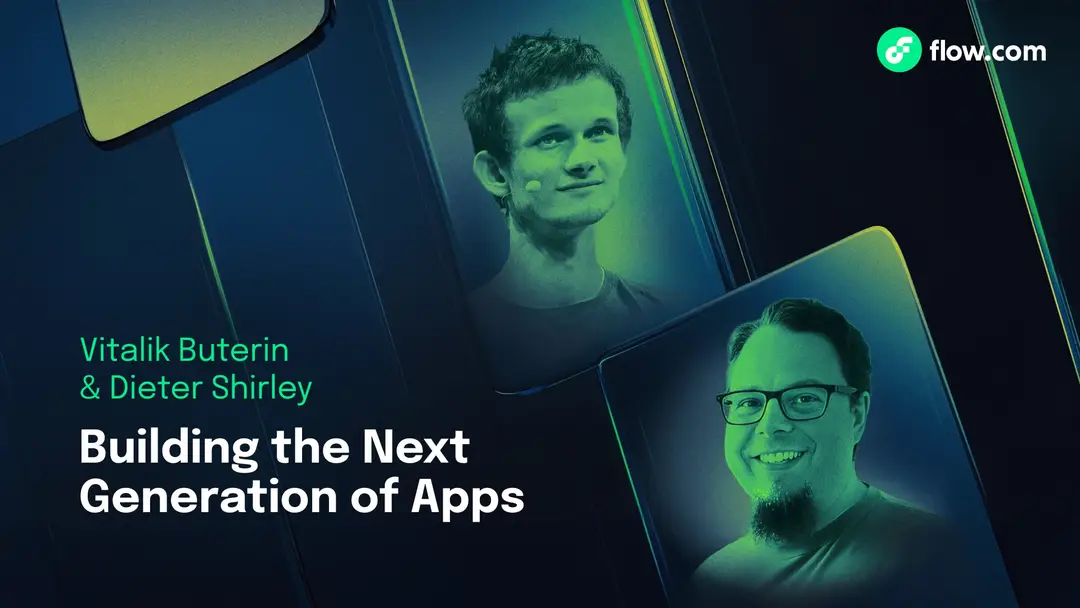
Source: Flow Blockchain
It’s exciting to hear that this is a theme builders are also seeing. It’s really time, and they should feel confident.
Cam: I really wanted to find a different answer just to say something unique, but I have to second that. I think consumer-facing apps are what we really need right now. One question we get asked a lot is, “When can Web3 get into mass adoption?” Right now, we’re just not seeing enough new people entering our circle. We really need a killer app to do that.
I think we have enough infrastructure at this point. It’s time to create good apps with strong user experiences that solve real problems and bring people in—whether that’s through gaming or social apps.
Harry: Yeah, we’re definitely seeing that trend—more people building consumer apps. I actually disagree slightly with Cam, though. I do think having better and more infrastructure is good, but traditionally, the emphasis has been too skewed toward infra. Now, we’re seeing ecosystems like Flow focus on consumers because the infra is ready. Now is the perfect time to build, and the responses from hackers highlight that.
Cam: Yeah, I would say hackers now are less focused on building new infra-level projects because that’s become very challenging. You really need a strong team, significant capital, and backing from top VCs to build something new at the infra level. It’s very difficult for regular builders to access those resources.
Matt: Recently, there’s been this joke—but there’s some truth to it—that some killer apps are starting to break out. Things like prediction markets are getting more traction and even surpassing the TVL of the protocols they’re built on. That can be discouraging for builders who see others raising funds for niche infra while their apps, which are good, struggle for recognition. But I think the tide is turning, and we’re excited to empower that shift.
Matt: Ali, I’m curious to hear from you too. You’ve probably seen some good themes and trends. What are you noticing?
Ali: I’ll approach this from a slightly different angle. What I’m seeing is the need to adopt practices that startups in Web2 have used for years. I know I might get some backlash for saying this because Web3 can be pretty tribal, but hear me out.
When I was doing my first Web2 startup, all my mentors told me to do customer discovery interviews—really understand the customers and the pains they’re facing before building anything. I wanted to jump straight into programming because I already had an idea in my head about what problem I was solving.
I remember thinking, “If Ford listened to what his customers wanted, he would have built a faster horse instead of a zero-to-one car.” I had a lot of ego in my early 20s, and I ignored that advice. I went through accelerator programs like TechStars, and the messaging kept coming: “Talk to your users.” But I didn’t. When my startup launched and no users showed up, it was a huge hit to my ego.
I realized all the adoption problems were because I hadn’t listened. I hadn’t talked to a single user. I spent months building something that wasn’t solving a problem people were willing to pay for. After that, I made a commitment to always think about the pain I’m solving before I start building.
I think we need to see more of that among builders in Web3.
Ali: The second part about consumer apps is another lesson I learned from doing a Web2 startup. When I was starting out, I really overemphasized the features of my application—the technical features. The feedback I kept getting from these world-class founders was, "Don’t talk about the features. Talk about the value propositions—the why and what’s being solved."
A lot of times, as engineers, we launch a project, and we’re in love with the features and the tech. It’s like, “Oh my God, this is 40% faster, and we’re using MongoDB that allows this.” But what pain are you solving for the end user? That’s the key. A lot of the time, the pain goes beyond the technology. The technology often needs to be abstracted away, and the value propositions need to be emphasized. That’s how you unlock mainstream consumers and build more consumer-centric apps.
Making the transition from a product lens focused on technical details to one focused on creating genuine community, product-market fit, and solving real user pains is crucial. A good analogy is how people often ask, “When will Web3 get its next killer app?” If you look at a different vertical, like artificial intelligence, it’s been around for decades. One of our co-workers wrote one of the first papers on LLMs over a decade ago.
But AI didn’t really take off with the public until ChatGPT launched. It became the fastest onboarded tool in history. Why? Because someone created a product that was consumer-centric, leveraging AI while abstracting away the technicalities. Before ChatGPT, if you talked to the average person about AI, they’d think it was complicated or related to something like Terminator or Skynet. Now, people see AI as a tool their grandmother can use to get a recipe, or their brother can use to build a video game, or a student can use to study for exams.
The reason for this shift is that ChatGPT provided value in a way that resonated with everyday users. For Web3 applications, if we change our paradigm to think about the value and adopt a consumer-centric mindset, we can usher in the next killer app that brings in millions of users and solves real pains.
Matt: We couldn’t agree more. That’s such a great comment. I think we’ve gotten used to “plumbing in public,” if you will—seeing all the rough edges exposed and just accepting them. But when you show that to someone who’s never experienced it before, it’s shocking to them. Even something as simple as “Connect Wallet” can be a hurdle.
Wonderful insight. I think we’ll wrap it up here. Thank you so much to both of you from HackQuest. We’re super excited about what you’re doing, what you’ve already done, and what’s coming next. Here we are, in Singapore on the terrace, heading into the ETHGlobal hackathon, and it feels like the stars are aligning. Maybe it always feels that way, but it feels extra that way today. I’m excited about what’s coming in the future.
Ali: I just want to add something really quick at the end. It’s time for me to shamelessly shill. The rewards platform we were talking about—whether you’re a developer or a user—you can start taking advantage of it right now. All you have to do is go to rewards.flow.com.
As a user, you can start locking in your Flow to get really impressive APY yields. Coming very soon, you’ll also be able to interact with a plethora of consumer applications. Interacting with those will create a lot of opportunities and perks.
Just giving you the earliest alpha—if you didn’t hear it already, you heard it here first. If you’re a developer participating in these hackathons as part of the world tour, we’re starting in Singapore, focusing on DeFi. We’ll be going to Thailand and San Francisco to explore themes like gaming, sports, and the gig economy. Whether you’re contributing in person, online, or even doing a side project on GitHub in the Flow ecosystem, what you’re working on today will tie into future rewards.
I don’t want to give too much alpha, but let’s just say: When Lambo? That’s all I’ll say.